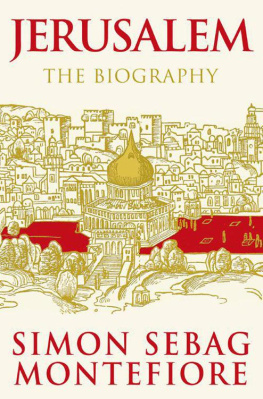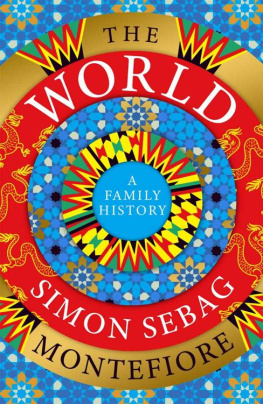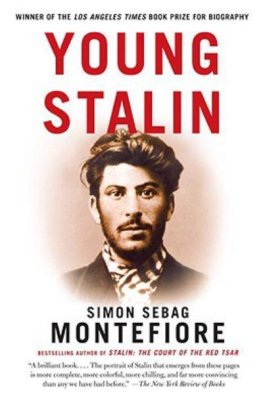Simon Sebag Montefiore was born in 1965 and read history at Gonville & Caius College, Cambridge University. Catherine the Great & Potemkin was shortlisted for the Samuel Johnson, Duff Cooper and Marsh Biography Prizes. Stalin: The Court of the Red Tsar won the History Book of the Year Prize at the British Book Awards. Young Stalin won the Costa Biography Award (UK), the LA Times Book Prize for Biography (US), Le Grand Prix de la Biographie Politique (France) and the Kreisky Prize for Political Literature (Austria). Montefiores books are published in 40 languages. His latest book is Jerusalem: The Biography. He is also the author of the novel Sashenka. A Fellow of the Royal Society of Literature and Visiting Professor at Buckingham University, he lives in London with his wife, the novelist Santa Montefiore, and their two children. He is the presenter of the BBC TV series, Jerusalem: the Making of a Holy City. For more information or to contact the author, see www.simonsebagmontefiore.com or follow him on Twitter @simonmontefiore
John Bew is Harris Fellow in Modern British History and Director of Studies at Peterhouse, Cambridge. His biography of Lord Castlereagh, Enlightenment, War and Tyranny, was published in 2011.
Martyn Frampton is Lecturer in Modern/Contemporary History at Queen Mary, University of London. His publications include The Long March (2009) and Legion of the Rearguard (2010)
Dan Jones is a journalist and historian. He is the author of Summer of Blood (2009) and The Plantagenets (2012).
Claudia Renton is a writer and actress who has appeared on stage with the RSC and at the Royal National Theatre, and on television for the BBC and ITV.
TITANS OF HISTORY
SIMON SEBAG MONTEFIORE
With John Bew, Martyn Frampton,
Dan Jones and Claudia Renton


New York London
2012 by Simon Sebag Montefiore
All rights reserved. No part of this book may be reproduced in any form or by any electronic or mechanical means, including information storage and retrieval systems, without permission in writing from the publisher, except by reviewers, who may quote brief passages in a review. Scanning, uploading, and electronic distribution of this book or the facilitation of the same without the permission of the publisher is prohibited.
Please purchase only authorized electronic editions, and do not participate in or encourage electronic piracy of copyrighted materials. Your support of the authors rights is appreciated.
Any member of educational institutions wishing to photocopy part or all of the work for classroom use or anthology should send inquiries to Permissions c/o Quercus Publishing Inc., 31 West 57th Street, 6th Floor, New York, NY 10019, or to .
ISBN 978-1-62365-222-7
Distributed in the United States and Canada by Random House Publisher Services
c/o Random House, 1745 Broadway
New York, NY 10019
www.quercus.com
TO MY DARLING CHILDREN LILY AND SASHA
Contents
ACKNOWLEDGMENTS
Thank you to David North, Mark Smith, Patrick Carpenter and my editor, Josh Ireland, at Quercus; to my fellow contributors Dan Jones, Claudia Renton, John Bew and Martyn Frampton, all gifted historians; my agent Georgina Capel, Anthony Cheetham, Slav Todorov, Richard Milbank, Mark Hawkins-Dady; Professor F. M. Eloischari; Robert Hardman, Jonathan Foreman. And, above all, my darling children Lily and Sasha and my wife Santa.
INTRODUCTION
When I was a child, I read a short articlelike one of those contained in this bookabout the sinister world of Josef Stalin. It fascinated me enough to make me read more on the subject. Many years later, I found myself working in the Russian archives to research my first book on Stalin. My aim is that these short biographies will encourage and inspire readers to find out more about these extraordinary individualsthe men and women who created the world we live in today.
But history is not just the drama of the terrible and thrilling events of times gone by: we must understand our past to understand our present and future. Who controls the past controls the future, wrote George Orwell, author of 1984, and, Who controls the present controls the past. Karl Marx joked about Napoleon and his nephew Napoleon III that all historical facts and and personages appear twicethe first time as a tragedy, the second time as farce. Marx was wrong about thisas he was about much else: history does not repeat itself but it contains many warnings and lessons. Great men and women have rightly studied history to help them steer the present. For example three of the 20th centurys most homicidal monsters, Hitler, Stalin and Maoall of whom appear in this bookwere history buffs who spent much of both their misspent youths and their years in power reading about their own historical heroes.
At the time that Hitler came to order the slaughter of European Jewry in the Holocaust, he was encouraged by the Ottoman massacres of the Armenians during the First World War: Who now remembers the Armenians? he mused. The Armenian massacres feature in this book. When Stalin ordered the Great Terror, he looked back to the atrocities of his hero, Ivan the Terrible: Who now remembers the nobles killed by Ivan the Terrible? he asked his henchmen. Ivan the Terrible too is in this book. And Mao Zedong, as he unleashed waves of mass killings on China, was inspired by the First Emperor, another character who can be found in this books pages.
This is a collection of biographies of individuals who have each somehow changed the course of world events. This list can never be either complete or quite satisfactory: I have chosen the names; thus the list is totally subjective. There may be names you think are missing and others whose very inclusion you question: that is the fun and frustration of lists. You will find familiar names hereElvis Presley, Jack Kennedy, Jesus Christ, Bismarck and Winston Churchill for examplebut also many you may not know. Our modern world is dominated by the Near and Far East so that in this book you will not just find traditional leaders such as Henry VIII or George Washington but also the creators of the rising powers of today: Ayatollah Khomeini, Supreme Leader of Islamic Iran, Deng, who forged modern China, King Ibn Saud, founder of Saudi Arabia.
When I started this project, I tried to divide these characters into good and bad, but I realized that this was futile because many of the greatestNapoleon, Cromwell, Genghis Khan, Peter the Great, to name just a fewcombined the heroic with the monstrous. In this book, I leave it to you to make such judgments. We can go further still: the political and artistic genius of even the most admirable of these characters requires ambition, insensitivity, egocentricity, ruthlessness, even madness, as much it demands decency and heroism. Reasonable people, said George Bernard Shaw, adapt themselves to the world. Unreasonable people adapt the world to themselves. Therefore change is only possible through unreasonable people. Greatness needs courage (above all) and willpower, charisma, intelligence and creativity but it also demands characteristics that we often associate with the least admirable people: reckless risk-taking, brutal determination, sexual thrill-seeking, brazen showmanship, obsession close to fixation and something approaching insanity. In other words, the qualities required for greatness and wickedness, for heroism and monstrosity, for brilliant, decent philanthropy and brutal dystopian murderousness are not too far distant from each other. The Norwegians alone have a word for this:
Next page







